Obviously, you can use different brands of memory on your system. But don’t take it as a definitive answer. Numerous aspects make this question a bewildering subject.
This article will provide you with the nitty-gritty of mismatching RAMs from different brands and manufacturers.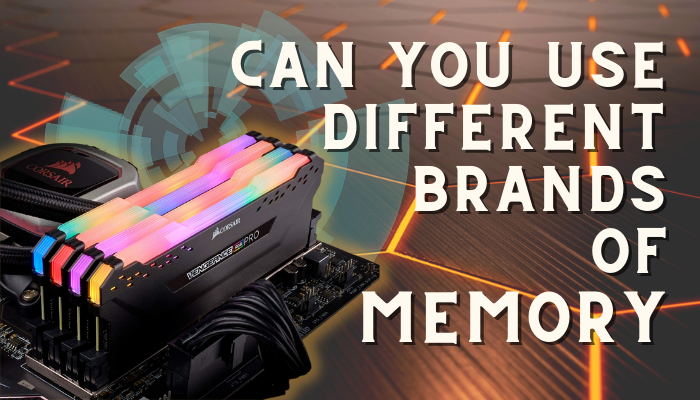
So without further delay, let’s give it a fleeting glance, shall we?
Considerations for Issues Due to Mismatching Memory Brands
As simple as mixing up different brands of RAM modules of a system sounds, it does not always work out with flying colors. Although DDR technology has come a long way over the years, it can still pose formidable issues.
On that premise, I’ve simulated different sequences of events that you may possibly encounter while upgrading your system memory.
Note: I ran all the tests on the Ryzen 5 5600X and RTX 3080 test bench. As a baseline, I paired 2x8GB 3200mhz CL-16 kits.
Check out our separate post on Windows memory Diagnostic Vs. Memtest.
Speed & Latency
There’s a myth about mixing memory kits with diverse mega transfer rates from different brands; it produces a huge performance deficit compared to a system paired with identical RAMs.
Here’s the truth— Faster RAM has no problem clocking down and matching the lower-clocked memory at all. Pairing a high-speed kit with a comparatively lower one will force the system to run all the memory at the lowest maximum speed. But it does not always take a performance hit. Let me clear it up a bit.
Let’s say you have two RAMs running at 2666 and 3200Mhz, respectively. Your PC will go up to 2666Mhz at max on each memory module.
Now, on my test bench, I recreated this situation, and the results are surprising compared to the baseline scores.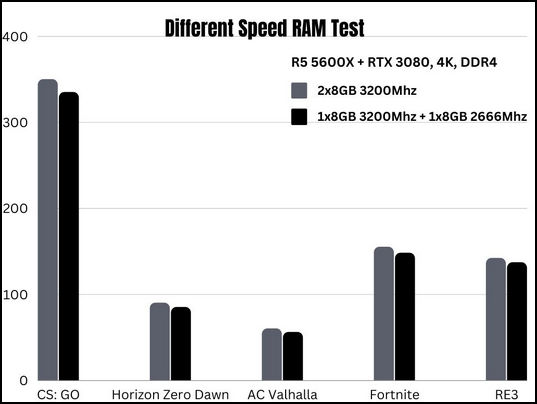 As you can see from the data chart, I lost a mere 5% of performance across the board. But there’s another popular question that remains; What about stutters? Luckily that was no issue for my system.
As you can see from the data chart, I lost a mere 5% of performance across the board. But there’s another popular question that remains; What about stutters? Luckily that was no issue for my system.
Taking things up a notch, I paired a 4000Mhz kit with a 2666Mhz. And my PC failed to boot.
For a bit more interesting perspective, I replaced the test rig CPU with 5600G; as we already know, AMD’s APUs are quite sensitive regarding memory configuration. We ran the same tests again.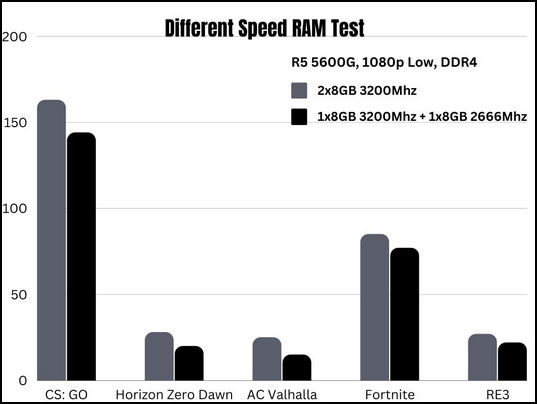 And this time, the numbers are all over the place. The performance hit is too great to ignore. It’s over 10% and sometimes goes beyond 15%. That makes the claims on the internet about mismatching memory speed true, doesn’t it?
And this time, the numbers are all over the place. The performance hit is too great to ignore. It’s over 10% and sometimes goes beyond 15%. That makes the claims on the internet about mismatching memory speed true, doesn’t it?
Not so fast!
As the previous test showed a positive result, it’s safe to say this depends on the processor type and generation.
You can tell the same thing for mixing different brand memories with mismatched primary timing. When it happens, all kits tune their timing to the lowest number.
Storage
Mixing different memory buffer RAMs from different brands is another factor to consider. It creates asynchronous operations with minimal performance deviation. But the speed and primary timing must be the same.
In this type of situation, your system will still be able to enable the Dual Channel mode. It’s a bit different than the standard Dual Channel.
So, I ran a test on my test rig with the same rated RAM except for the capacity. And it delivered the exact performance as our reference system. However, if you exceed the memory limit on one kit, you will encounter performance issues.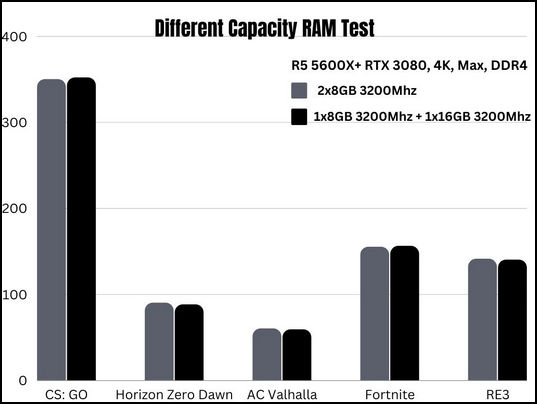 For instance, a system with 8GB and 16GB 3200Mhz CL-16 will work perfectly fine until the workload doesn’t exceed the smallest 8GB stick. Chances for this type of circumstance are slim if you are a casual gamer or office worker.
For instance, a system with 8GB and 16GB 3200Mhz CL-16 will work perfectly fine until the workload doesn’t exceed the smallest 8GB stick. Chances for this type of circumstance are slim if you are a casual gamer or office worker.
Memory Channel
One of the most pivotal technologies to squeeze the last bit of performance out of a system is the multi-memory channel. When you combine different brand memories, Dual channel mode takes a hit and handicaps the system performance.
So, how much does it matter?
The good news is; it depends on the type of hardware you have. The memory channel can make a huge difference in APU (Accelerated Processing Unit) performance, incorporating the processing and graphics cores on the same die. And I see up to 40-50% performance hit.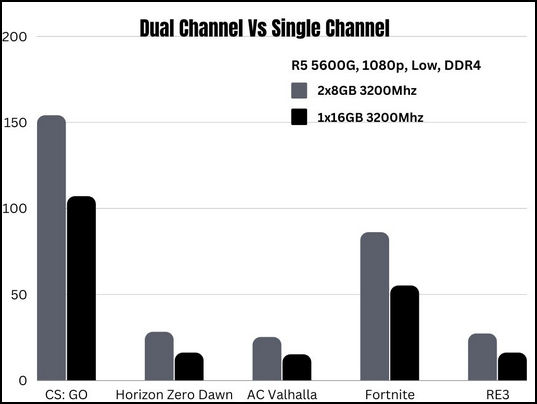 Now, I tried a few things on my reference system. First, I ran a test on Single Channel vs Dual Channel mode. Got better results on the latter mode as expected.
Now, I tried a few things on my reference system. First, I ran a test on Single Channel vs Dual Channel mode. Got better results on the latter mode as expected.
Then I populated the A1, A2, and B1 slots on the mainboard with 3200mhz memory modules. The system ran fine with Dual Channel enabled on A1 and B1 slots but Single Channel mode on B2. This is called the Flex mode. And I got the expected maximum performance.
Installing a different RAM on B1 apart from the reference model brand of 2666Mhz clock speed, my system threw a memory error and no post. But once I clocked down the faster memory to 2666Mhz, the test rig worked like a charm.
So, while mixing different RAM sticks from different vendors, pay attention to which order you populate the slots.
Memory Chips
Whether your system should produce memory-related issues depends highly on the manufacturer. Oh no, I’m not talking about the brand of your RAM; it’s the actual chip makers.
The black rectangular chunks soldered on the PCB are the memory chips. Samsung, Hynix, Micron etc., are the most popular, to name a few.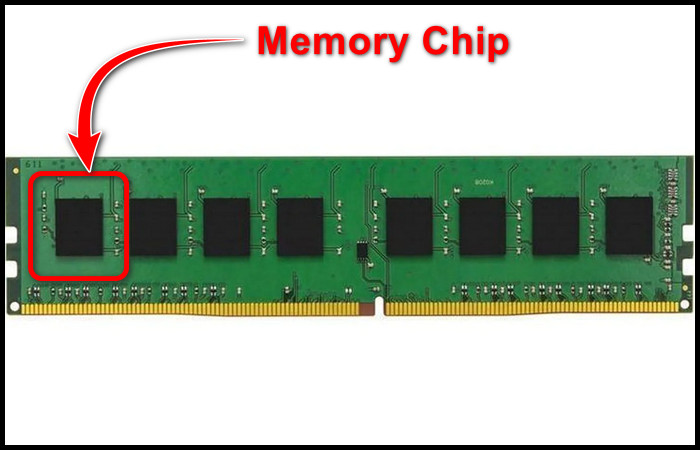 When you install memories with different chips, your system will probably run into stability issues such as being stuck on a black screen, Dual channel mode problems, system crashes, etc.
When you install memories with different chips, your system will probably run into stability issues such as being stuck on a black screen, Dual channel mode problems, system crashes, etc.
To illustrate, I paired a G-Skill 8GB 3200Mhz kit with a Thermaltake Toughram 8GB 3200Mhz. Both had similar primary timings. The first one had Samsung B Die, and the latter had Hynix CJR.
My test rig booted normally, but once I tried to switch on XMP, it did not post at all. But this won’t be the same for everyone. Just a vulnerability is introduced for the future to cause numerous issues out of nowhere.
Voltage
Standard DDR4 memories use 1.2V, whereas slightly overclocked kits may come with 1.35 to 1.4V.
Voltage can vary from one brand to another. When you mix them on a system, the RAM kit with high voltage requirements will not get enough power because the memory with lower voltage will limit power delivery. As a result, your system will not reach the peak performance level.
Let’s understand this with a simple analogy.
Imagine two workers carrying bricks to a building. While the first person can climb up and down the stairs 10 times/hr, and the second goes 7 times/hr. But they have to go back and forth together.
So, the first worker taps out when exhausted after climbing the stairs as per his energy limit. And the second worker also cannot go beyond 7 times, even if he has some strength left to do some extra work. RAMs with lower rated voltage hold back a high voltage memory, just like this.
Should You Mix Different Brands of RAM?
Look, the reality is you don’t mix RAM from multiple manufacturers when you build the PC in the first place. It’s when you upgrade the computer down the road.
On paper, you can mix and match different RAM brands in your system and call it a day. However, you may bump into stability issues such as a black screen, BSOD, freezing, stuttering and overall performance drop. Playing around in the BIOS and tweaking some values may help.
So far, I’ve shown you all these possible circumstances you can come across. Now the big question remains; Should you mix different brands of memories?
No, you should not unless you are out of options. But is there anything that you can do to improve the odds?
First of all, try to sell the old memory sticks on eBay or other online marketplaces. Buy a new pair of kits from the same batch. If that’s not possible, choose system memories that match timing, clock speed, capacity, chip type and voltage as much as possible.
That will remove the point of unpredictability and provide you with a great user experience.
FAQs
Can I use 2 16GB And 2 8GB Ram Together?
Yes, you can use 2 16GB and 2 8GB RAMs together. Install them in Dual Channel mode, and it will work asynchronously.
Can I Use Different Bus Speed RAM?
Yes, you can use different bus speed RAM on your computer. But all installed memory will run at the lowest maximum available speed.
Can You Mix Different RAM Voltages?
Yes, you can mix different RAM voltages and get your system up and running. However, your system may become inconsistent in terms of stability and overall performance.
Can You Mix DDR3 and DDR4 RAM?
No, you cannot mix DDR3 and DDR4 memories together. They have different dimension and the slots are different.
Ending Remarks
While upgrading system memory, availability is the primary reason you may have to mix different brands of RAM. Always try to buy RAMs from a single batch.
When you buy a memory from a different company make sure speed,timing & voltage match each other. Hope this article enlightened you why these factors matter.
Comment down below if you have any questions.




